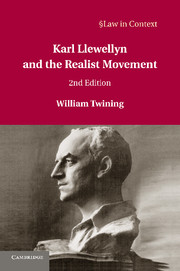Book contents
- Frontmatter
- Contents
- Foreword
- Preface
- Postscript
- Acknowledgements
- Abbreviations
- Part I The Rise of the Realist Movement 1870–1931
- Introduction
- 1 Langdell's Harvard
- 2 Corbin's Yale, 1897–1918
- 3 Columbia in the 1920s
- 4 The Aftermath of the Split
- 5 The Realist Controversy, 1930–1931
- Part II The Life and Work of Karl Llewellyn: A Case Study
- Part III Conclusion
- Appendices
5 - The Realist Controversy, 1930–1931
from Part I - The Rise of the Realist Movement 1870–1931
Published online by Cambridge University Press: 05 December 2012
- Frontmatter
- Contents
- Foreword
- Preface
- Postscript
- Acknowledgements
- Abbreviations
- Part I The Rise of the Realist Movement 1870–1931
- Introduction
- 1 Langdell's Harvard
- 2 Corbin's Yale, 1897–1918
- 3 Columbia in the 1920s
- 4 The Aftermath of the Split
- 5 The Realist Controversy, 1930–1931
- Part II The Life and Work of Karl Llewellyn: A Case Study
- Part III Conclusion
- Appendices
Summary
Up to 1929 the ferment at Yale and Columbia was neither expressed nor interpreted in terms of ‘legal realism’. A number of theoretical papers had been published by Hohfeld, Corbin, Cook, Oliphant and Moore, but most of these dealt with particular topics and only one or two invited interpretation as a call for a new brand of legal theory. The developments at Yale, the Columbia curriculum discussions and the deanship crisis, the establishment of the Johns Hopkins Institute and the Yale Institute of Human Relations, had all attracted attention, at least among academic lawyers, but they had for the most part developed pragmatically and at a relatively down-to-earth level. The first general discussion of ‘legal realism’ as a distinct form of jurisprudence was a paper by Karl Llewellyn, which appeared in the Columbia Law Review in 1930. Llewellyn had been a pupil of Corbin, Hohfeld and Cook at Yale and, as a relatively junior member of the faculty, he had participated in the events at Columbia between 1924 and 1928. In 1929 Llewellyn was invited to give a paper on ‘Modern Concepts of Law’ at a Round Table on Current Trends in Political and Legal Thought. This was published in the following year under the title ‘A Realistic Jurisprudence – The Next Step’. Although his own contribution to developments at Yale and Columbia had been relatively insignificant up to this time, Llewellyn was particularly well qualified to identify some of the new trends, to place them in the context of their intellectual history, and to suggest possible lines for future development. In this first round of the realist debate he missed the opportunity.
- Type
- Chapter
- Information
- Karl Llewellyn and the Realist Movement , pp. 70 - 84Publisher: Cambridge University PressPrint publication year: 2012
- 4
- Cited by



